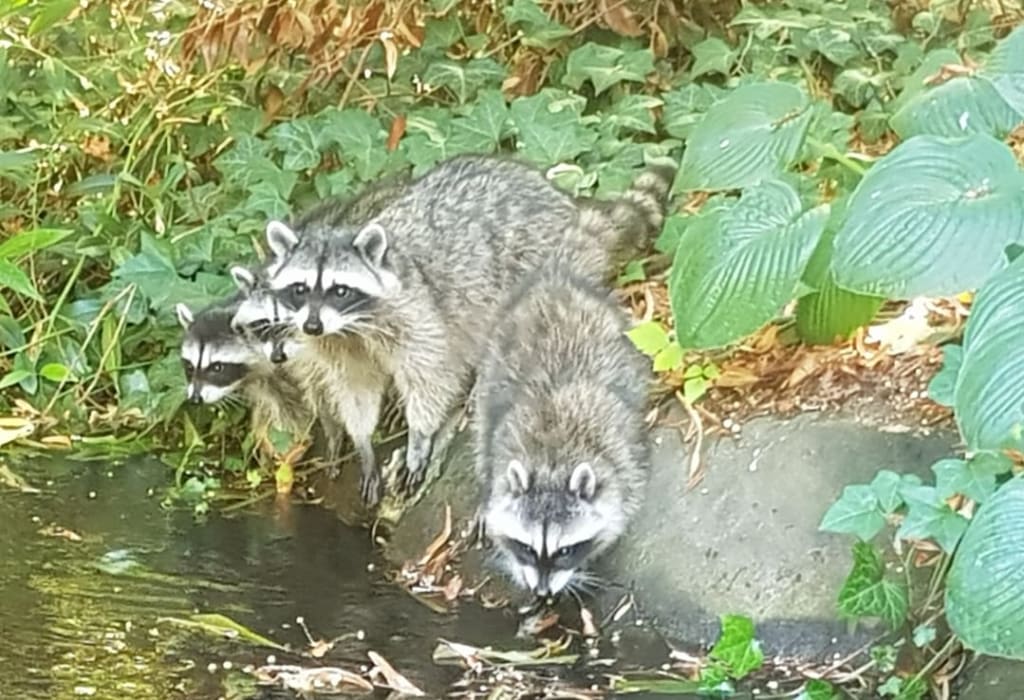
Raccoons. Love them? Let me tell you more. Hate them? Let me change your mind.
They're my favourite animal ever—apart from my dog, Bobby. They're cute, funny, relatable and little evil geniuses. Read on for some rac-facts!
Yes, they can be vicious little bastards. Yes, they can hiss at you. Yes, they can be very cranky and yes, they can be just downright mean. But isn't that all of us before our morning coffee? (This isn't to say you should give a raccoon coffee—that wouldn't end well for either party.)
Raccoons (Procyon Lotor) are full of little quirks. They have collapsible spines; they have tiny little sense receptors on their front paws and that cute little bandit mask on their face to make it easier to rob banks. Er, I mean it's to aid them see in the dark as it reduces glare. This being said, some theorists say each raccoon has a unique mask so they can recognise each other.
It's a common misconception that raccoons wash their food before eating it because they're simply hygienic—whilst this appears to be the case, it's actually so they can gather more sensory information about the grub whilst simultaneously looking around for predators.
Opportunistic omnivores, raccoons will eat pretty much anything they can get their grubby little paws on—but will mainly stick to insects, aquatic creatures such as crayfish, nuts and berries. Oh and also the stuff you throw out, adhering to the common stereotype of them riffling through the trash.
Raccoons are about as fussy as their homes as they are about their food. Once upon a time, they'd only be found within woodland, near streams and rural areas—skip forward to 2018 and they're able to live anywhere they please, since raccoons are now so well adapted to humans. They can live anywhere between trees or even your attic! Say goodbye to your Christmas decs.
Why are some raccoons fat and others skinny, I hear you cry? This is because they gorge themselves on food during spring and summer in preparation for winter (much like myself)—whilst raccoons don't technically hibernate, they sleep through most of winter so it's important for them to stay warm and full of food.
Females, AKA Sows, will have a litter (otherwise known as Gaze or Nursery) of between 1-6 baby raccoons (otherwise known as Kits) in early Spring. She will typically train these little ninjas up for around a year before separating. Whilst they go their separate ways, adult raccoons will live in little "neighbourhoods" of between 5-6 raccoons for better protection against predators—safety in numbers.
Raccoons have around 15 calls and 200 sounds they can use to communicate with each other—I have personally heard one of them and I can vouch that it sounds adorable.
It's no secret raccoons steal things and run off with food that's not theirs - they do this with their opposable thumbs. They can also run on their hind legs, just like humans, to make a quick getaway.
Sadly, raccoons only live 2-3 years in the wild, yet up to 20 years in captivity. Adopt, people! Long live the Lotor!
Raccoons have the flight response whilst experiencing acute stress response, better known as "Flight or Fight." They will generally only attack when feeling threatened, protecting their young or if they have a disease like Rabies.
I'm not stupid—I know they can be destructive. I know they can be vicious. But everyone gets a little hangry sometimes, right?
*Not an expert. Just an enthusiast. :)*
About the Creator
Kathryn Cobb
Bad at bio's. Occasionally write something good.






Comments
There are no comments for this story
Be the first to respond and start the conversation.